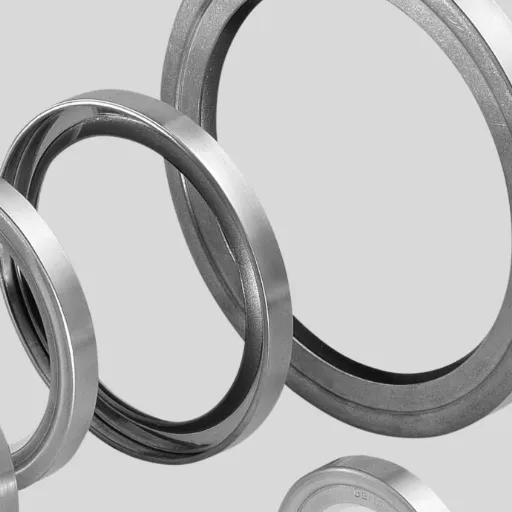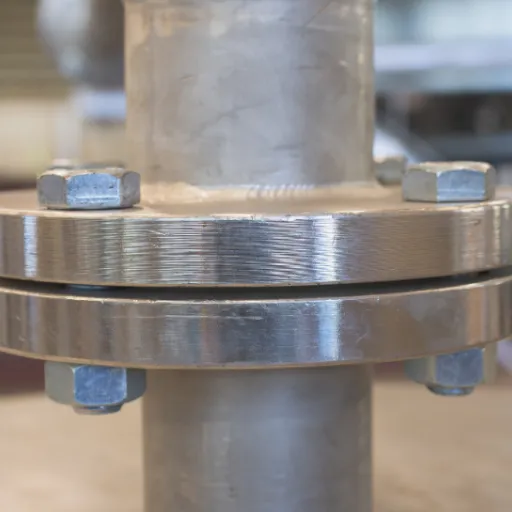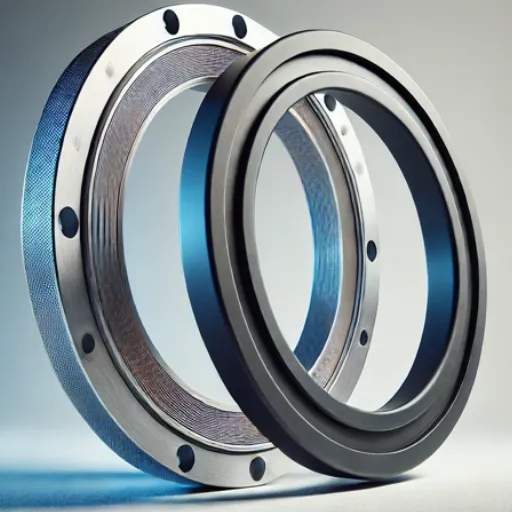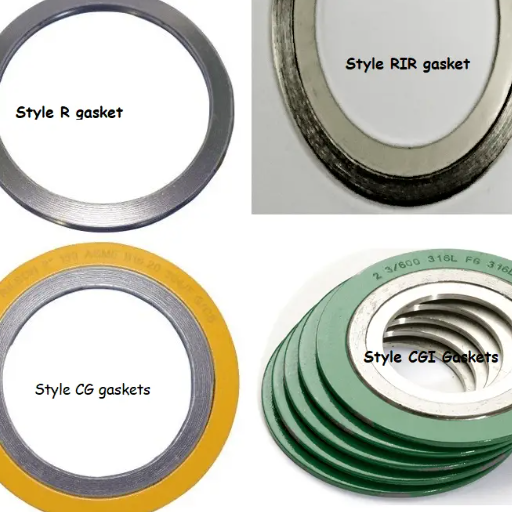When talking about the right flange in relation to welding applications, two popular choices emerge-weld neck flanges and slip-on flanges. Both have their different advantages and are used for varied applications depending on requirements such as pressure, simplicity of installation, or durability. This article will discuss what differentiates weld neck flange vs slip on flange while citing their advantages and drawbacks and potential uses. At the end of this article, you will have enough knowledge to actually discern which type of flange is fit for your own project, hence assuring maximum performance and reliability in piping systems.
Understanding Flange Types

Flanges are essential parts of any piping system, acting as connecting points for pipes, valves, and other equipment. Used in high-pressure and high-temperature environments, weld neck flanges, with their long and tapered hub, offer superb support and allow for smooth fluid flow. In contrast, slip-on flanges are simpler to install and are more economical since they simply slide over the pipe and demand less precision during fitting. These flanges are, however, better suitable for lower-pressure systems due to their sheer simplicity. When considering a choice between these two flange types, the determining factors should be pressure levels, installation, and cost considerations of your project.
What is a Weld Neck Flange?
A weld neck flange is designed for high-pressure and high-temperature applications. Providing reinforcement due to a long-tapered hub, this flange proves excellent for critical and demanding applications where strength and durability count. A weld neck flange is welded to one pipe to render a strong connection that can hold up against leakage; this kind of welding reduces stress bearing on the flange base while concurrently improving flow characteristics of the fluid within the pipeline. Industry-wise, weld neck flanges are used mostly in oil and gas, chemical processing, and power generation, where reliability and safety considerations have utmost importance.
What is a Slip-On Flange?
A slip-on flange slips over the pipe end. Afterward, it is welded in place. It is a simple connection, cost-effective, easy to install, and easy to align. Yet, it cannot be as well and far less ideal than the weld neck flange when tested against its strength and endurance abilities. Slip-on flanges find their most frequent use in low-pressure applications that do not require much strength or durability from the flange. These make the slip-on flange versatile and easy to install, useful in industries that seek an efficient and easy piping connection.
Key Differences Between Weld Neck and Slip-On Flanges
Where these two flanges are concerned, there are some key distinguishing features to consider. Due to their design considerations, weld neck flanges are to be chosen for applications characterized by high pressure and high temperature, where the overall structural integrity is of utmost importance. The flanges feature the tapered hub and welding directly to the pipe, which allows for stress to be distributed evenly between the flange and pipe, giving rise to less chance of failure through fatigue mechanisms.
Slip-on flanges, conversely, suit applications of a lower-pressure nature, in which emphasis is placed on ease of installation and cost-efficiency. They slip over the pipe; then they are welded in place and require less time and precision for installation compared to the weld neck. However, to some extent, by design, they do compromise on strength and durability, which can be attributed to the tapered hub and weld arrangement of the weld neck flange.
Ultimately, the demands of a particular application dictate the choice between weld neck and slip-on flanges. Weld neck flanges provide superior security for industries in which utmost considerations are placed upon performance and reliability under severe conditions. On the other hand, where slip-on flanges shine is in less arduous systems, where pragmatism and economic value are the fine details.
Applications of Each Flange Type

Weld Neck Flanges: These flanges are generally used in systems operating under high pressure, high temperature, or under service conditions that are very harsh locations, including oil and gas pipelines, chemical processing plants, and power generation facilities. A matter of critical consideration is that, due to the robust construction of these flanges, the possibilities of leakage are almost nil.
Slip-On Flanges: These are utilized in low situations wherein the cost factor and ease of installation are prioritized. Low-pressure water lines, HVAC systems, and general industrial piping are considered in such applications. Their versatility and cheap price make them very preferred for less demanding systems.
When to Use Weld Neck Flanges
Weld neck flange installations should comprise high-pressure, high-temperature, or critical stress considerations. Their tapered hub and strong attachment to the pipe make them preferable in the oil and gas, chemical processing, and power-generation fields. I strongly recommend the installation of weld neck flanges for any applications that give minimal chances of leakages, as they are highly reliable in sealing due to their design. These are very commonly used in systems wherein the piping integrity is of utmost concern concerning safety and efficiency.
When to Use Slip-On Flanges
Slip-on flanges are recommended when considerations such as ease of installation and economy are most important. I generally recommend slip-on flanges for applications under lower pressure, wherein a tight, high-integrity seal is not paramount. They slide over the pipe and weld both internally and externally, providing reasonable strength and leakage resistance under less demanding circumstances. These flanges are widely used in water treatment plants, HVAC systems, and low-pressure pipelines owing to their versatility and initial low cost compared to weld neck flanges. Different types of flanges might be required in cases where high-pressure resistance or critical safety standards must be met.
Comparative Applications: Weld Neck vs. Slip-On
| Parameter | Weld Neck | Slip-On |
|---|---|---|
| Strength | High | Moderate |
| Pressure | High | Low-Medium |
| Temperature | High | Moderate |
| Leakage | Low | Moderate |
| Cost | High | Low |
| Installation | Complex | Easy |
| Applications | Critical | General |
Choosing the Right Flange for Your Needs

Choosing the appropriate flange involves an assessment of its corresponding system needs, such as pressure, temperature, environment, and the application itself. Weld neck flanges, larger in robust structural dimension, are used more suitably with really high-pressure or high-temperature systems to resist such forces and offer durability. Slip-on flanges, on the other hand, are cheaper, easier to install, and provide enough strength for low-pressure or noncritical systems. Next would come considerations such as the type of fluid or gas transported, system maintenance, and budget, all of which will ensure the flange serves well and efficiently for many years.
Factors to Consider in Flange Selection
Flanges can be selected incorporating present-day knowledge and techniques that guarantee correct performance and enhance value for money. From recent data taken from search trends, the material composition keeps the first slot among these. The common flange materials, such as stainless steel, carbon steel, and special alloys, must be appropriately chosen with respect to the operating environment consisting of temperature, corrosion, and chemical compatibility. There is also an increased search interest in pressure ratings of flanges, with those searching for related specs ensuring their systems are compatible with high-pressure applications through ASME and ANSI codes.
The other highly vital factor is lifecycle cost, as modern industrial design increasingly focuses on finally arriving at a compromise between initial cost and long-term viability. The ease of installation and maintenance of access is of the top considerations, especially for the pharmaceutical and food industries, where the hygiene standards apply. By combining the above with those specific requirements, companies truly gain more on efficiency, safety, and increased reliability of the whole system.
Cost Considerations: weld neck flange vs slip on flange
| Parameter | Weld Neck | Slip-On |
|---|---|---|
| Cost | High | Low |
| Strength | High | Moderate |
| Pressure | High | Low-Medium |
| Installation | Complex | Simple |
| Durability | High | Moderate |
| Leak Risk | Low | Moderate |
| Applications | High-stress | Low-stress |
High-Quality Flanges: What to Look For
Material quality is the most prioritized factor; the flanges made out of stainless steel, carbon steel, or alloy steel are highly durable, depending on their application. The manufacturing process of the flange requires precision, with the flanges being accurately dimensioned and smooth-finished to give a secure and leak-proof seat. I also consider industry specifications such as ASME, ANSI, or DIN to ensure the flanges meet safe and tested benchmarks. Finally, I check out the reputation, reliability, and certification availability of a flange supplier because this builds on the overall quality and trustworthiness of its products. Armed with this information, I can confidently select flanges for any system.
Conclusion

The right flanges are selected by giving a serious look at key factors like material compatibility, pressure-temperature ratings, exact dimensions, and surface finish to give a reliable and leak-proof seat. It is then important to check for recognized industry standards such as ASME or ANSI and give preference to a highly-reputed supplier with proper certifications in hand for guaranteed safety, performance, and quality. And at the end of the day, when these questions are addressed, an informed decision can be made on an application basis for a system.
Summary of Key Differences
A sealing solution is typically distinguished from another by material composition, design specificity, and performance appropriateness. For instance, ring gaskets work well in high-pressure situations due to their strength, whereas spiral wound gaskets provide flexibility and the ability to handle thermal cycling. Critical in performance are choices on materials like graphite to withstand extreme temperatures and PTFE for chemical resistance. Moreover, adherence to more modern standards like the ASME B16.20 assures listing and safety for all applications. Considering the most up-to-date information coming out of search engines, it is glaringly obvious that the selection of sealing solutions must be based on both the operational environment and durability requirements of the system.
Final Recommendations
Start with the complete assessment of the system operating conditions vis-a-vis pressure, temperature, and corrosive material. Present trends emphasize the use of materials such as graphite for high-temperature applications and elastomers like Viton for systems exposed to sets of aggressive chemicals.
Furthermore, ensure that all components comply with standards such as ASME B16.20 or ISO 15848 in security, quality, and emission control.Market data trends point out a rising preference toward sealing solutions focusing on environmental safety, thus giving more and more importance to low-emission gaskets. Consider coating systems or modifications like PTFE overlays to further improve the performance and useful life even under very challenging conditions. Finally, ensuring an optimum match between the sealing technology on one hand and static and dynamic sealing requirements of the specific equipment on the other enhances the sealing system’s efficiency, minimizes downtime, and maximizes the whole system’s reliability.
Future Trends in Flange Applications
we can identify some crucial trends for flange applications in the coming times. One major trend is the smart integration of industrial components: IoT flanges are being developed. These smart flanges are mounted with sensors that monitor temperature, pressure, and other crucial parameters in real time so that they can serve to predict maintenance schedules to avoid failures.
Besides, there is an increased need for advanced materials for flange manufacturing, especially composite materials providing high strength without compromising the lightweight property. This corresponds to growing concerns about sustainability and reducing energy consumption at both production and operational stages. Low-carbon manufacturing and recyclable materials are already industry-standard expectations.
Another actively growing presence is flange adaptation for renewable energy systems like wind turbines and solar plants. Such applications need highly durable and accurate flanges that can handle extreme conditions without compromising performance. We are also witnessing increased traction toward modular flange designs for better flexibility and ease of installation, particularly for complex piping or offshore projects.
These developments stand for an industry where efficiency, sustainability, and cutting-edge functionalities are the core issues so that flange applications remain frontliners in industrial and environmental advancements.
These innovations reflect an industry prioritizing efficiency, sustainability, and advanced functionality, ensuring flange applications remain at the forefront of industrial and environmental progress.
Reference Sources
-
Academia.edu: Discusses orifice flanges, including weld neck and slip-on types, with details on their manufacturing and applications. View Source
-
Cornell Law School (CFR): Provides regulations on flanged joints, including the use of welding neck flanges and their welding requirements. View Source
-
Austin Peay State University: A mechanical division document discussing ASTM standards for forged steel slip-on and weld neck flanges. View Source
- Top Weld Neck Flanges Suppliers in China
Frequently Asked Questions (FAQs)
What is the difference between slip-on flanges and weld neck flanges?
The primary difference between slip-on flanges and weld neck flanges lies in their design and application. A slip-on flange is designed to slip over the end of a pipe and is welded on both the inside and outside, making it easier to install. In contrast, a weld neck flange has a long neck that gradually transitions to the flange, ensuring a full penetration weld, which is critical for high-pressure applications. The weld neck flange also provides a stronger connection to the pipe, making it more suitable for demanding industrial environments. Choosing the right flange depends on the specific needs of your project, including pressure ratings and installation ease. Thus, understanding flange vs slip on flange characteristics is essential.
How do I choose the right flange for my needs?
Choosing the right flange for your needs involves evaluating several factors, including the type of connection required and the pressure applications you’ll encounter. Weld neck flanges are often preferred for high-pressure systems due to their robust design and ability to handle stress. Slip-on flanges, on the other hand, offer ease of installation and are generally more cost-effective. Consider the initial cost of weld neck flanges versus slip-on options, as well as the long-term performance and reliability in your specific application. Assessing flange faces and the welding seam quality will also help you decide which flange type is best suited for your project.
Are weld neck flanges better than slip-on flanges?
Weld neck flanges and slip-on flanges each have their advantages, depending on the application. Weld neck flanges are typically regarded as being better for high-pressure applications due to their stronger welded connection and ability to withstand stress. They are designed for a full penetration weld, ensuring durability and a tight seal. In contrast, slip-on flanges are easier to install, making them a popular alternative for less demanding applications. Understanding the key differences between these flange types will help you determine which one is more appropriate for your needs, especially when considering factors such as installation ease and cost.
What are the advantages of slip-on flanges?
Slip-on flanges offer several advantages that make them a popular choice for many applications. One of the primary benefits is their ease of installation; they simply slip over the end of the pipe and can be welded in place, which saves time and labor costs. Additionally, slip-on flanges are generally less expensive than weld neck flanges, making them an attractive option for budget-conscious projects. They are ideal for low-pressure applications where the risk of failure is minimal. However, it’s important to note that slip-on flanges may not provide the same strength and durability as weld neck flanges in high-pressure or critical applications. This makes it essential to evaluate the specific requirements of your project before deciding.
What types of welding are used for weld neck flanges?
Weld neck flanges are typically attached to pipes using various welding methods, with the most common being a full penetration weld. This type of weld ensures a strong, leak-proof connection between the flange and the pipe. Other welding methods like socket weld and fillet weld may also be used in different contexts, but full penetration welding is preferred for high-pressure applications. The welding seam quality is critical in ensuring the integrity of the joint, particularly in demanding industrial applications. Understanding the importance of the welding process and how it affects the performance of the flange can help you make an informed decision on which flange type to use.






